Executive Summary
For financial advisors, an ongoing client service model often means finding ways to keep clients engaged and progressing toward their goals outside of the 1 or 2 typical client review meetings each year. For clients, more frequent communication can be a source of behavioral coaching and helpful information that can better equip them to stay the course through rocky markets. Which means that by engaging clients more frequently, advisors can strengthen the client-advisor relationship while providing clients with timely behavioral coaching and valuable information, ultimately leading to deeper trust, fewer worried phone calls or 'emergency' meetings, and potentially even more client referrals. What's challenging, however, is figuring out how to reach each client consistently while delivering insights on subjects that they care about and making it easy for them to engage further.
In this guest post, Ashby Daniels, a financial advisor with Shorebridge Wealth Management and creator of Money Visuals, discusses how a 'private' email newsletter can help reinforce the value that advisors provide in a way that can be scaled across an entire client base.
Although newsletters are made to be sent to many people at once, from a client's perspective, they can be seen as a much more intimate form of communication. That's because people tend to be selective about whom they let into their inbox: They often filter out those who aren't friends or family and those who don't otherwise bring value into their lives. And because (at least from the client's perspective) it feels as though the message is being sent to them directly, an email newsletter can feel like a much more direct and personal mode of communication than other content channels such as blogs, podcasts, and videos that are openly accessible to everyone. Because a client who receives a newsletter from their advisor needs only to hit the "Reply" button to respond and engage with the advisor, any email newsletter really is just 1 step away from a more direct, 1-to-1 conversation.
In terms of choosing what to include in the newsletter, it can make sense to break the content down into several sections that can be repeated in each edition for consistency and repeatability. Topics can vary from market insights to financial planning-related topics to recommended reading to personal and business updates (and many other potential topics), but the most important thing to get across is the advisor's own perspective on what's going on (since that perspective often is what allows clients to feel the most confident about their own situation). Which can even be done when outsourcing newsletter content, so long as the philosophy and communication style of the writer aligns with the advisor's own – a potential option for advisors who lack the time or don't feel as comfortable with writing.
The key point is that newsletters can be a valuable tool even for advisors who aren't naturally inclined to write. This is because clients don't generally value perfection or exact certainty as much as they value consistency and authenticity. On the one hand, this means that advisors can choose any cadence for sending a newsletter (weekly, monthly, etc.) that they feel comfortable with – so long as they are able to consistently stay with that schedule. On the other hand, a personal note that offers a glimpse of the advisor as a human can often be more interesting and engaging for the client than a technical article on a complex financial topic. In the end, while creating a client newsletter does take time, that time spent can have a high impact on the quality of the advisor's client relationships – and can even bring in more clients in the process – by regularly reinforcing the value that the advisor brings to the relationship!
As Financial Advisors (and Advicers!), we spend a great deal of time trying to generate new client relationships. Everybody has their own unique form of marketing in which to do this. Some might prefer focusing on referrals or seminars, while others are interested in blogging, podcasting, and building a social media following. To be clear, generating new business is important to the future of your advisory practice, but I've found there's often a gap that follows the marketing funnel.
That is, once your clients are on board, what are you doing to keep them engaged outside of your client meetings? What are you doing to communicate with them in a way that nurtures the relationship further while helping them become more successful clients in the process? What are you doing to provide the behavioral coaching you know your clients need in a way your clients might actually enjoy and find valuable?
This is where a private client newsletter can help. In writing my own for the last 5 years and by helping hundreds of other advisors publish their client newsletters through our Money Visuals Client Memos service, it's easy to see the numerous benefits of publishing a regular client newsletter. Here are just a few of the benefits:
- Increased Client Engagement (at scale)
- Increased Referrals (the best way to get more referrals is to stay top-of-mind)
- Fewer Worried Phone Calls (increased efficiency)
- Fewer 'Emergency' Meetings (less stress and more efficiency)
The simple value proposition of a private client newsletter is that it enhances current client relationships, makes the advisor's business more efficient, and increases their stream of referrals by staying top-of-mind.
Keeping those benefits in mind, let's begin with what a private client newsletter is and what makes it a uniquely valuable tool.
What Is A Private Client Newsletter?
A private client newsletter is an email communication designed to be sent privately to your clients (and prospects) that reinforces the value you provide. You may use it to help your clients make sense of what's going on in the markets, answer questions you've been getting so everyone can benefit from hearing the answer, or discuss topics of interest within your niche.
Reasons Private Client Newsletters Are Unique
The goal we're pursuing by publishing an email newsletter is to add value to your client and prospect relationships at scale. You might be asking yourself, "Why not utilize a blog, podcast, or YouTube channel for this same content? What makes a newsletter so special?!" Let's explore 4 reasons why.
Reason #1: Inboxes Are Sacred
As much as we may loathe email (hand raised!), or perhaps because of how we feel about email, we are selective about who we let into our inboxes.
The people we are trying to reach are no different. They are professionals and they protect their inboxes.
It's reserved for friends and people who bring value into their lives. And I sure hope that, as their advisor or prospective advisor, you are bringing value to their life on a regular basis.
Think of it this way: Simply having the permission to send them emails means you are on the same level as their family and closest friends.
Reason #2: Emails Are A 1-To-1 Communication
Everyone knows that blogs, podcasts, and YouTube channels are 1-to-many mediums. And people recognize that those mediums are primarily a means of marketing some sort of service, even when they are educational in nature. This very article is an example of this strategy.
But newsletters aren't perceived in quite the same way because of their privacy.
If you were trying to sell something, you would obviously blast it out into the world where everyone could see it instead of keeping it limited to the privacy of an email inbox.
Your clients perceive it this way, and so do your prospects. Again, this comes back to the intimate nature of the inbox.
And when it's done right, it feels 1-to-1, even when it isn't. And how it feels matters. A lot.
Reason #3: It's 1-To-1 At Scale
Taking this 1-to-1 feeling even further, you can have this impact at scale. You may be sending your newsletter to 100 people or 10,000 people, but the recipient is none the wiser.
To them, it feels like you're speaking to them personally, because with an email, you are speaking directly to them.
What makes that direct connection all the more valuable is what truly sets email apart from every other medium…
Reason #4: They Can Immediately Start A Conversation With You
Perhaps the greatest point of leverage a newsletter has over all other mediums is the "Reply Button."
As I've said, the goal of a newsletter is to encourage engagement with your clients and prospects.
And if you offer opportunities to engage with you, the minute that readers feel a desire to ask a question, share a personal story, request a meeting, or (for prospects) begin a relationship outside of the inbox, all they have to do is click Reply.
That's powerful.
Every other medium has friction. They all require the consumer to take 2 or 3 steps to reach you, which for most people is 1 or 2 steps too many, and so they may never do it.
Not with a newsletter. They just click the reply button and the relationship takes an immediate step forward.
Correct me if I'm wrong, but clients who are engaged are almost always our best clients, yes? That's what a client newsletter can do that no other medium can – engage the reader with as little friction as possible. And again, it does this at scale.
Okay, so you're hopefully convinced that a newsletter is worth pursuing. Let's move to what a good newsletter might look like.
What To Include In Your Private Client Newsletters
I started sending an email newsletter to my personal clients in 2018. And when I started, I had 3 primary goals in mind, which remain the same to this day. The goals were as follows:
- I wanted to communicate intimately with clients at scale;
- I wanted to encourage my clients to stay the course through all markets using a positive, historically relevant message; and
- I wanted a consistent way to generate engagement from my clients.
With those goals in mind, I created the following format to write my newsletter each month, and I've continued with this same format ever since. That's what I'm going to share below, along with my thought process behind each section.
My client newsletter is broken into 4 parts, including a discussion of year-to-date market returns, a financial and investment planning note, resources, and a personal note.
Let's spend some time discussing each of these elements and why I include them.
Section 1: Market Returns Year-to-Date
While none of my clients evaluate their portfolios against any respective index benchmark, I still want clients to be informed as to how the various markets are performing so that they can have a reference point for our discussions. For what it's worth, I actually preach against benchmark comparisons since the only relevant benchmark is where they stand relative to their goals. Either way, I think sharing the market's general performance offers perspective for when they open their statements.
Here's how I display the performance of various indices:
Section 2: Financial & Investment Planning Note
In the second section, I include a financial and investment planning note where I write about something that's happening in the market, but I explain what's happening through the lens of history and that of a long-term investor. In other words, this is the section in which I'm providing "behavioral coaching." Though, I've never heard anyone say they felt like it was coaching or preaching. It's just me helping them make sense of what's going on in the world in a conversational way.
I'll share much more about this specific section under the subheading "So, What Should You Write About?!" down below.
Section 3: Resources
Generally speaking, I share 1 to 3 articles I've found from the previous month that I think are interesting or valuable. Some may offer some perspective on the market, but most will be on the topic of how to live a better, more fulfilling life, along with a few sentences of commentary from me as to what it's about and why I'd encourage them to read it.
A few examples might include some of the writings of Morgan Housel, Arthur Brooks, or Joy Lere.
Section 4: Personal Updates
While I believe that all of the above sections – a market return summary, a financial/investment planning note, and a short list of resources – are valuable for encouraging good client behavior and building trust in your process, this personal section is what makes for lifelong clients. In this section, I share what's going on with my children, my spouse, and my business. I include what my sons are into during whatever season we're in, what my wife has been up to, and some silly personal stuff.
For example, during COVID, I trained for and ran a half-marathon literally by myself (remember 6 feet of personal space?) and documented that experience in short form. I'm a goal-oriented person, so I'll often include various personal challenges I'm putting myself through, like how to become a better cook, etc. In an odd way, the weirder, the better.
As they say, if you want people to be interestED, then be interestING. Based on personal experience, the bar is surprisingly low to being interesting. 😊
I'll also typically share one or two photos of my kids or our family doing some kind of fun activity. I've shared Halloween photos, vacation photos, my children playing sports, and photos from an award ceremony for my children.
For advisors who haven't shared much of their personal life, you may be thinking that this could come across as unprofessional or that you might be oversharing.
While you know your clients better than I do, I can tell you from my personal experience and from hundreds of other advisors that when we show who we are as people outside of our business, it humanizes us in the best possible way. Remember, they chose to work with you for a reason, and it's not because of your portfolios!
I'd argue that sharing some things from your personal life helps your clients to grow closer to you and feel more connected to you both as their advisor and friend. I believe it also helps our clients make the connection that they aren't just choosing to do business with us, but are helping to support our families as well.
Section 4+: How To Generate Engagement From Your Clients
At the bottom of the Personal Section, I almost always include a request. I encourage clients to reply by sharing something like the following:
- Share your summer vacation plans
- Recent photos of the family
- Personal goals they are working toward
This has been a great way for me to follow up with them on a personal level. As one example, when a client responds with where they are going and when, I put it on my task list to follow up to ask how the trip was.
If you really want to go above and beyond, send a bottle of wine to their room, wherever they're staying. Even just calling to follow up on a trip is a great way to show that you care about them as people and not just the financial aspects of their lives.
Bonus Section: Opportunity To Share
When I was still taking on new clients, the bottom of my email always included two things. One is, of course, the disclaimers required by our compliance team. But those are at the very bottom. Right above the disclaimers, I'd include the following language, or something like it:
Want to share this?
If you would like to share this Client Memo with a family member or friend, please feel encouraged to forward it to them.
If this email has been forwarded to you and you would like to subscribe, please visit the link below.
Subscribe to Receive our Client Memo [This is hyperlinked to your Landing Page]
This little extra section can help grow your mailing list and will likely lead to new clients over time since most people added will be friends and family of your existing clients.
For advisors who have segregated their email list between clients and prospects, you could be a little more specific in your footer to further engage both your clients and prospects. Readers can download a Word document that includes a sample of 2 additional footer options here.
There are infinite possibilities for what other good newsletters might look like, but I've found this combination to be quite well-received.
Now for the most popular question I receive from advisors wanting to launch a client newsletter…
How Often Should You Send Your Newsletter?
Your primary options are weekly, twice monthly, or monthly. We'll dive into these options in a moment, but before we do, here's my core belief: Consistency matters much more than cadence.
The following sections talk about a few reasons why consistency is most important.
How You Do Anything Is How You Do Everything
By consistently showing up in a client or prospect's inbox on predetermined delivery dates and times, you are showing that you take your job seriously.
Reid Hoffman once said, "Consistency + Time = Trust." I think that's true.
If you're flaky with your newsletter, you may inadvertently be giving clients (and especially prospects) a reason to believe your advisory service model may be flaky as well.
Here's what I mean by predetermined delivery dates and times:
- If you decide on a weekly cadence, your newsletter should hit clients' inboxes at 11 a.m. every Thursday (or some other regular date/time).
- If twice monthly, it should arrive on the 1st and 15th (or 1st and 3rd Monday, or whatever) at 9 a.m. every single time.
- If monthly, you may send it on the 1st of every month at 12 p.m.
The specific days/dates/times don't matter all that much. What does matter is your commitment to those days/dates/times.
Inconsistency Causes Angst
As advisors, we often feel compelled to communicate more when the markets are volatile and communicate less when things are going well.
If you don't stick with your chosen cadence, you may inadvertently give your clients and prospects something to worry about.
For instance, if volatility picks up and you start sending newsletters every week when your typical cadence is monthly, they may worry because it gives the appearance that you may be worried.
This is the exact opposite effect we're seeking from sending a newsletter in the first place since a high-quality newsletter should result in fewer worried calls, fewer emergency appointments, and better client relationships!
Giving your clients something to worry about simply because you can't stick to a schedule is antithetical to your goals.
It's why I always encourage advisors who worry about the time and effort required to publish a newsletter to start with a monthly cadence. You can always increase that cadence with an announcement, but it's hard to go backward without looking like a slacker.
Consistency is a rarity in our world. Be someone they can depend on. Even more so, if you're consistent…
You Give Your Clients And Prospects Something To Look Forward To
When you publish on a regular schedule, your best clients and prospects will look forward to your newsletter.
There's a reason the best writers publish on a consistent day and time. Here are a few examples that immediately come to mind:
- Nick Murray's Newsletter – which I highly recommend every single advisor subscribe to – is published on the last business day of every month. I anticipate it every month and can't wait for it to hit my inbox.
- Tim Ferris has 5-Bullet Friday. It doesn't show up on Wednesdays.
- James Clear's 3-2-1 Newsletter is delivered every Thursday.
- Carl Richards' Behavior Gap email shows up on Thursdays as well.
- The entire com Nerd's Eye View content wheel operates on a schedule down to the hour in which they hit your inbox: Practice Management Mondays, FA Success Podcast Tuesdays, Technical Topic Wednesdays, Kitces & Carl (every other) Thursday, Weekend Reading Fridays.
See, it works!
For what it's worth, I send Client Memos to our Money Visuals members every Friday morning at 7:30 a.m. sharp.
Consistency matters.
What Cadence Should You Choose?
The answer depends on you.
If you are new to sending a client newsletter, I recommend starting with monthly because monthly isn't too daunting, which is important at this stage of the game.
Remember, consistency is most important, so it's best to start with something you're 100% sure you can maintain. Get some newsletters under your belt and then you can build up to the cadence that feels right for you and your clients if you want to do more.
In case you're curious, most of the advisors I speak with find twice per month to be a comfortable cadence for themselves and their clients/audience. This is my personal cadence as well.
That said, your audience matters most of all. What's right for your clients and prospects depends on them, and you know your audience better than anyone.
So, What Should You Write About?!
As advisors, we often think that our clients expect perfection.
We think they expect certainty around their goals and rates of return. We think they expect us to have an accurate 6-month forecast for the market and that we offer precision in the probability (an oxymoron) of achieving their goals. And much more.
I actually don't believe any of those things.
After 5 years of writing client newsletters, I can honestly say that what clients actually want is your personal perspective about what's going on. They want you to help them make sense of the crazy world around them.
They want a reminder that they are prepared. They want to know that you're paying attention to what's going on, and they'd like to hear what you're thinking as you're thinking it.
This is true even if what you're thinking is, "I don't know." because they can respect an honest answer.
A good advisor can express uncertainty about the short term while encouraging historical, fact-based optimism about the future. (I'd argue this is the healthiest perspective to have anyway, but I digress.) Each newsletter is an opportunity to remind them that they're prepared for the inevitable unknowns that lie ahead.
I know all of this to be true across tens of thousands of client relationships because the advisor members who subscribe to our Client Memo say they receive great responses from their clients expressing gratitude for helping them make sense of the world. I believe this mostly is because we're sharing consistently positive thoughts (which is unusual in our world today) in a way that helps our clients make better long-term decisions and gives them additional confidence in their plans.
Long story short, your newsletter is an opportunity to express your confidence in their plan on a regular basis. Plus, clear communication and optimism are hard to find in our world today, which makes you all the more valuable to your clients. Your writing doesn't have to be as perfect as you might think. Candidly, I break every rule in the grammar guides, but that's what makes it authentic. It's purposefully conversational. It's purposefully honest and straightforward.
I'd encourage you to take a similar approach in your client newsletter. Your clients will appreciate it more than you can imagine. If you don't believe me, give it a try.
All that being said, let's get more tactical about things….
How To Bring Your Newsletter To Life
I realize that coming up with content for a newsletter is a constant challenge for advisors, so I want to quickly review the sections again to provide you with a framework for making the creation of your newsletter as easy as possible.
Section 1 – Market Data: I'd recommend YCharts or WSJ for your market return data, or you could use your firm's return data to make compliance easier to manage.
Section 3 – Resources: There are limitless topics and articles that you can send to your clients from your weekly reading. I'd recommend sending articles that resonate with you. If you're still short on ideas, curator Tadas Viskanta runs a website called Abnormal Returns, where he shares hundreds of potential articles each week.
Section 4 – Personal: This section is entirely up to you as to what and how much you'd like to share, but hopefully, the guidelines I shared previously about my own approach are helpful.
That leaves us with just Section 2 (Financial & Investment Planning Note), which is where most people will find their content stumbling blocks, so I want to spend a little more time on this.
I believe there are two primary ways you can consistently offer great content within your newsletter:
- Perhaps the best way is to follow what Michael Kitces recommends in an earlier post, Creating Blog Content as a Financial Advisor: "Just write about the questions/issues that your top clients are facing or asking you about!" In other words, any question or concern you hear twice is a great place to start. It really is that simple.
- Outsource the Planning/Topical/Investing content. This is the equivalent of Dan Sullivan's "Who, Not How" philosophy that is built around outsourcing everything that you can so that you can focus solely on your unique abilities to better achieve your goals.
If you enjoy writing and have the time to do it, then I'd recommend doing exactly that. Within your client meetings alone, you'll find countless potential topics to write about.
On the other hand, if you see the clear value of sending a client newsletter but find the creation of this content to be overwhelming or too time-consuming, then let someone else do the heavy lifting for you and outsource it. Even for those who have the time and feel comfortable writing content, you may still find great value in outsourcing content—if for no other reason than to have a backup plan for when you get too busy, go on vacation, or generally lack something you want to write about. Having content in your back pocket can go a long way to minimizing the potential frustrations that come with maintaining your regular cadence and getting this off your to-do list.
Outsourcing Newsletter Content
If you choose to outsource your newsletter content, it's critical to find someone who shares your voice. You'll want someone who shares your general philosophy and communication style. No writer is going to be a fit for everyone, myself included, so be sure to spend some time finding that right person or service for you.
So, who might you outsource this to if you decide to do so?
As I've shared, I provide content like this for hundreds of advisors under my Client Memo membership within Money Visuals. But there are a number of other potential writers worth exploring as well. Here are a few who come to mind:
- Wendy Cook of Wendy J. Cook Communications
- Shawna Ohm of Content 151
- Derek Hagen of Meaningful Money
- Andy Hart (UK) of Humans Under Management
- Clearnomics
Invariably, there are many more.
Whether you choose to write your own content or to outsource it, my primary encouragement is to not let perfection stand in the way of getting this done. The rewards in terms of higher client engagement and stronger client relationships are worth the effort that's required. I'd argue that the time that is required to create and send your client newsletter will free up at least that amount of time (or likely far more) thanks to fewer frantic phone calls and meetings while deepening each of your client relationships at the same time.
Given that my goal here is to be as comprehensive as possible, I have one more recommendation to make your newsletter as successful as possible.
Name Your Newsletter
A few months ago, I was speaking with an advisor friend about strategies to increase the open rate on his newsletter. At the time, his open rate was just over 40%.
As we were brainstorming different ways to increase the open rate, he mentioned that the subject line of his newsletter was whatever the focus of his content was for that week.
Immediately, I knew what he should try first: He needed to name his newsletter.
You might think that having the topic as the subject line would be helpful, but it acts as a potential barrier to the opening of your newsletter because if the topic doesn't appear interesting, it will sometimes get deleted or ignored.
On the other hand, if your newsletter has a name and they've consistently found value in your writing, they are more likely to open it because they know you take great care in sending them valuable thoughts.
If your mind is running about what you might name your newsletter, don't overthink it. It could be as simple as one of the following:
- Firm Name Monthly Newsletter – September 2023
- Advisor Name Client Memo – September 2023
- Advisor Name September 2023 Newsletter
You can also name it something unique, like Tim Ferriss' 5-Bullet Friday. The key is that your clients and prospects will know what they are opening when they see the subject line.
To show the value of naming your newsletter, once my advisor friend named his newsletter, his open rates on those particular emails jumped almost immediately into the low 50s and have since risen into the high 50s. My hope is that as he continues to build 'brand awareness' around his re-branded client and prospect newsletter, his open rates will continue to increase.
I hope that I have conveyed the value of starting your own private client newsletter. While I believe that you should explore every way that you might market your expertise, I also believe that every single advisor should have a private client newsletter as part of their overall value offering. You may find, as so many other advisors have, that sending a high-quality private client newsletter is a high-leverage activity that can have an enormous impact on your client relationships and may bring in additional clients in the process.
If this article breeds questions or you have an interest in starting a client newsletter, please be encouraged to reach out to me at [email protected], and I'll do whatever I can to help. Thanks for reading!


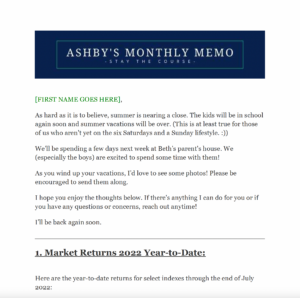
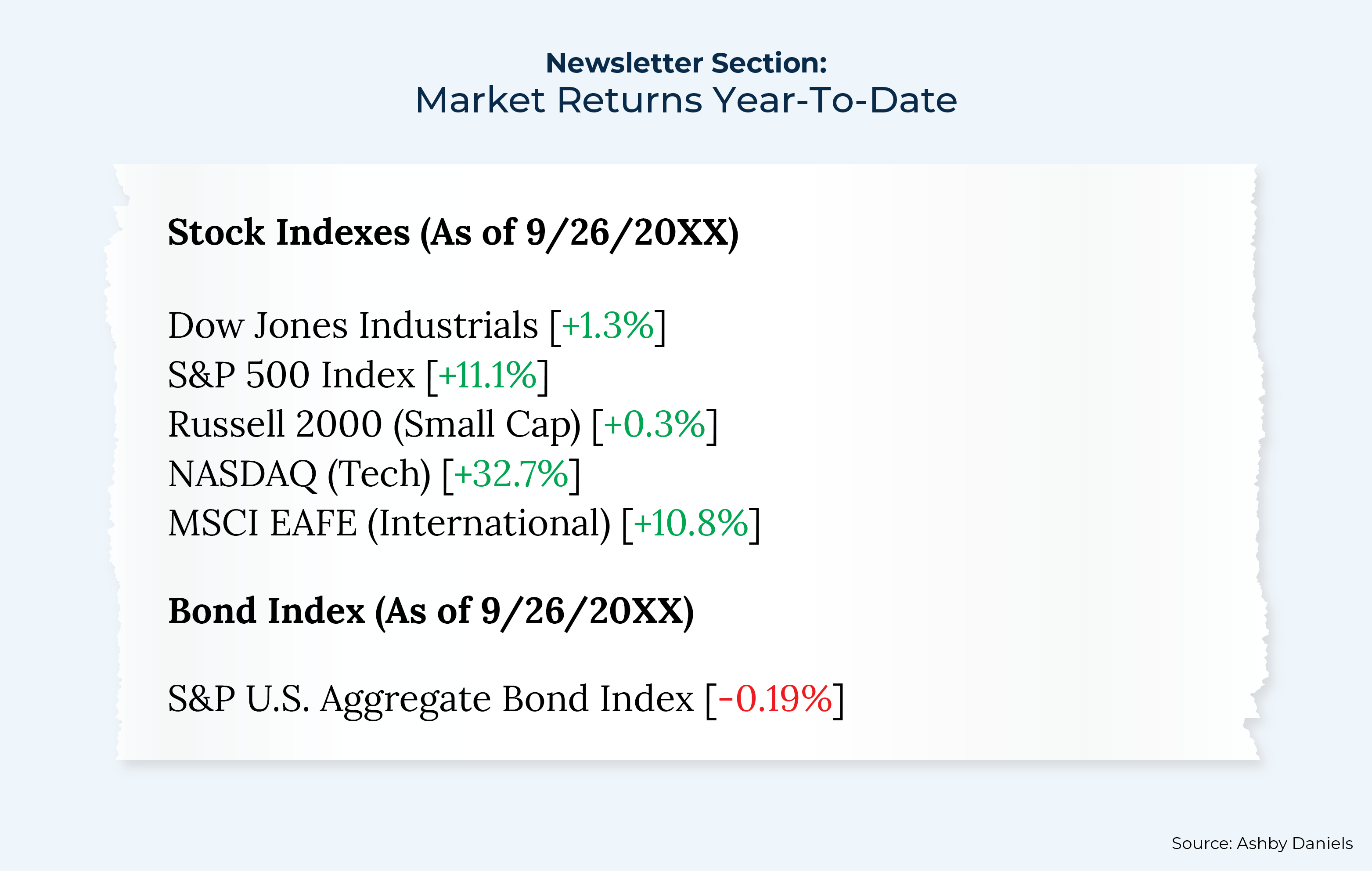
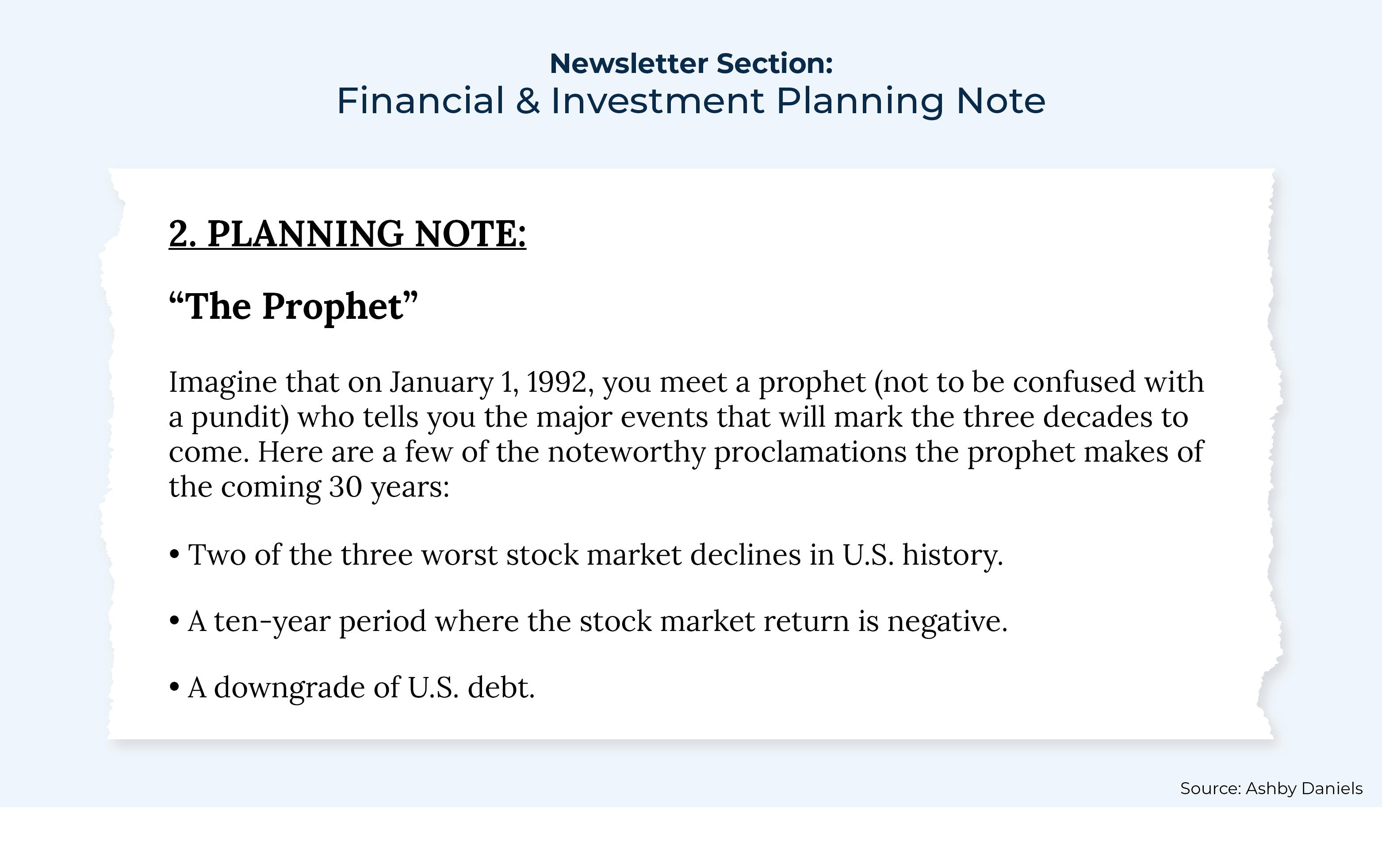
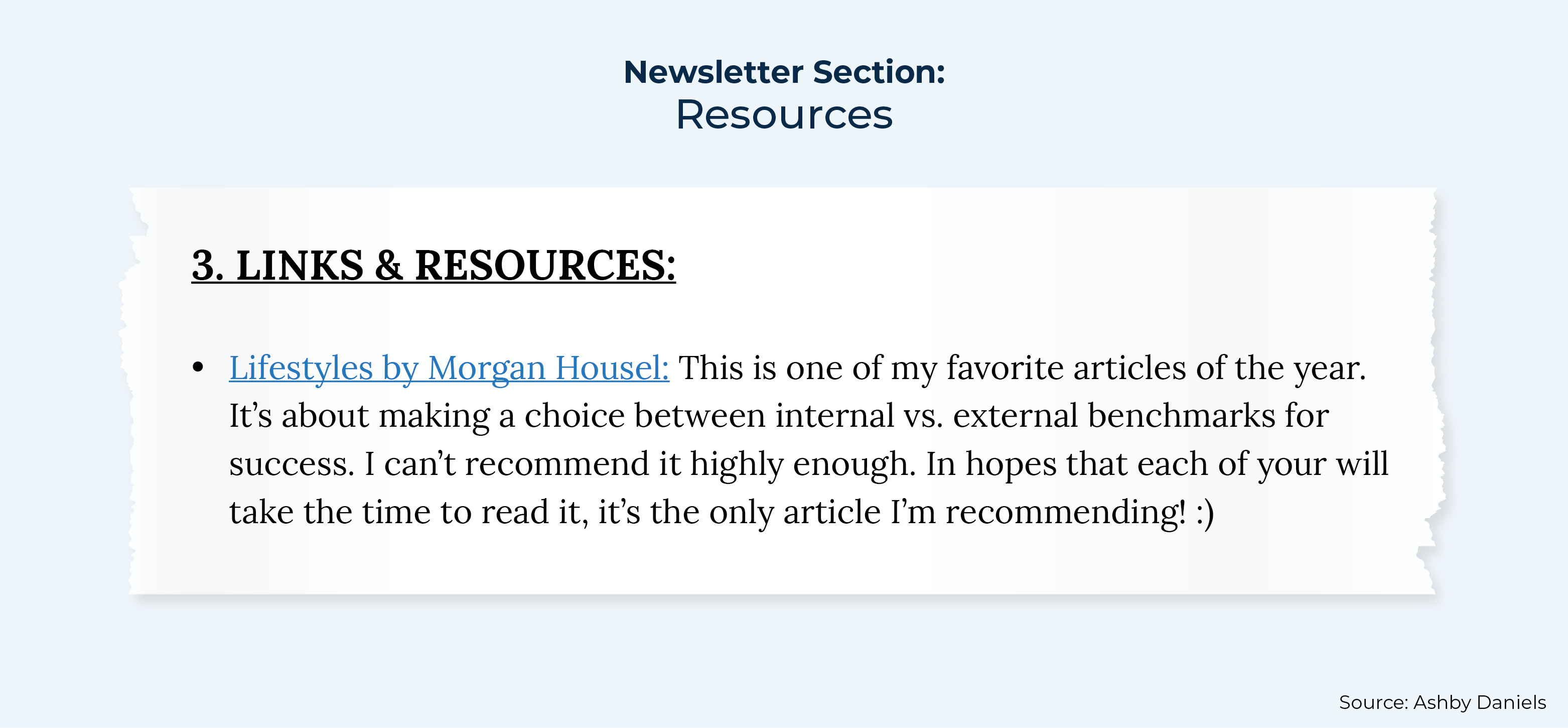
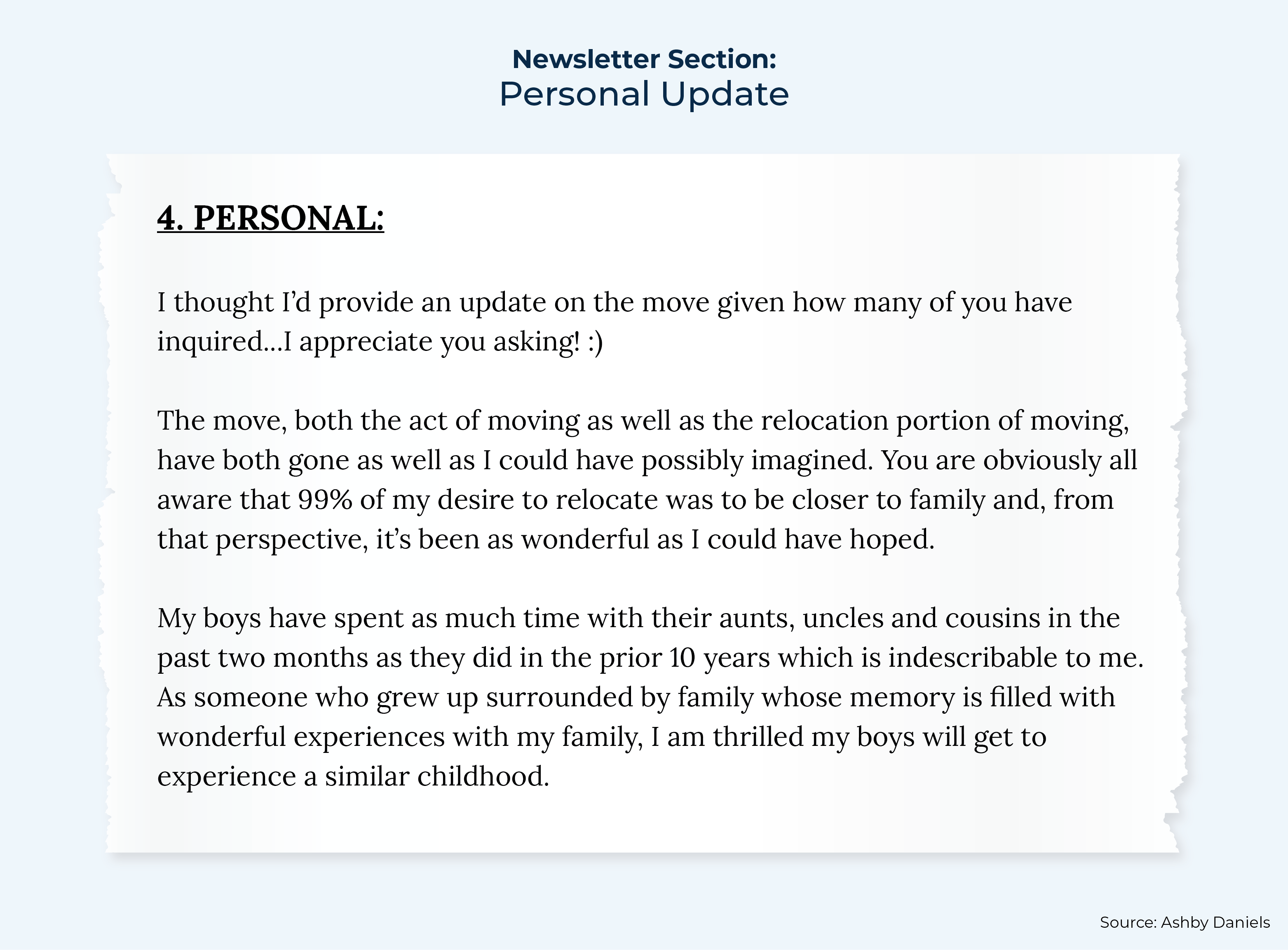
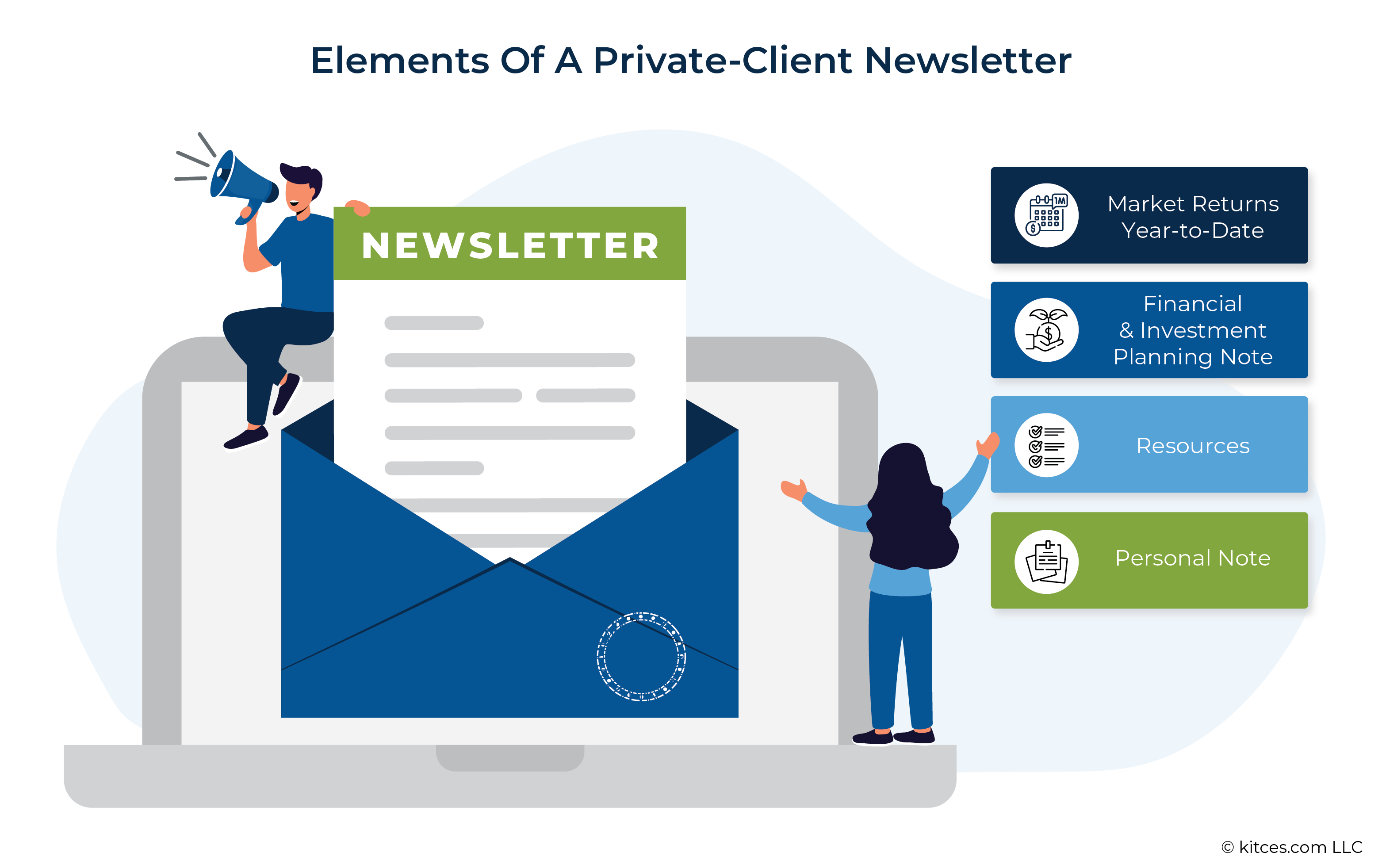



Leave a Reply